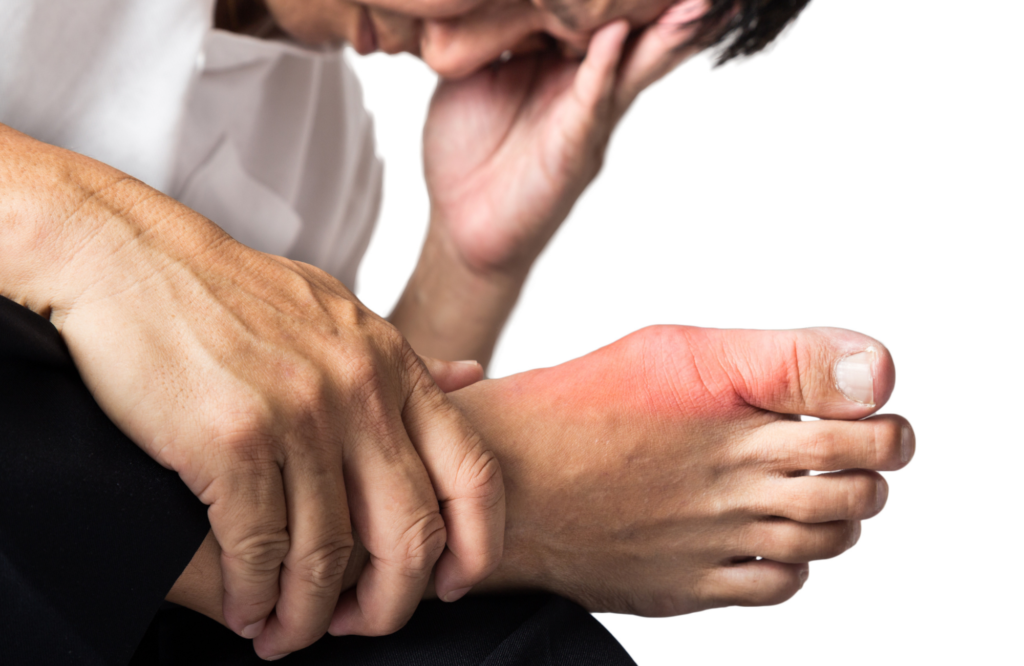Gout

Gout is a form of arthritis that can affect anyone
It often begins with burning pain in the big toe
Forget pretty much everything you’ve ever heard about gout. Here are the facts:
- Gout is not rare. In fact, gout is surprisingly common. More than 8 million Americans have gout and the numbers are growing. Gout is the most common form of arthritis in men over the age of 40.
- Gout not just a man’s disease. Men and women can get gout. Though men are overall 10 times more likely to develop gout, rates of gout tend to even out after age 60 since for women, gout tends to develop after menopause.
- People of all sizes get gout. Although obese people are at an increased risk, gout is more common in people who have other health problems like diabetes, high blood pressure, high cholesterol or kidney disease.
- Gout affects more areas than just the big toe. The big toe is the most common place for gout attacks to happen, and many people have their first gout attack in their big toe. But gout can happen in all joints in the body including the ankles, hands, elbows, and knees. When people have chronic gout, often several of their joints are affected.
- Gout will rarely go away on its own. While symptoms of a gout attack often go away within a few days, but that does not mean that gout is gone. Even if you don’t feel symptoms, urate crystals in the body can cause long-term health problems like joint and kidney damage.
- Changing diet can help, but won’t necessarily cure gout. There may be foods you should avoid if you are prone to gout, and certain foods you eat may help to decrease the level of uric acid in your body. But diet alone is not a cure. People with gout who follow a healthy diet may still need medicines to prevent gout attacks by lowering the level of uric acid in their body. Consuming foods and beverages that contain high levels of purines can trigger an attack of gout. Some foods contain more purines than others and have been associated with an increase of uric acid, which leads to gout. You may be able to reduce your chances of getting a gout attack by limiting or avoiding shellfish, organ meats (kidney, liver, etc.), red wine, beer and red meat.
- Heredity is a factor: The tendency to accumulate uric acid is often inherited. Other factors that put a person at risk for developing gout include: high blood pressure, diabetes, obesity, surgery, chemotherapy, stress and certain medications and vitamins. For example, the body’s ability to remove uric acid can be negatively affected by taking aspirin, some diuretic medications (“water pills”) and the vitamin niacin (also called nicotinic acid). While gout is more common in men aged 40 to 60 years, it can occur in younger men as well as in women.
What is gout?
Gout is a disorder that results from the buildup of uric acid in the tissues or a joint. It most often affects the joint of the big toe.
Gout attacks are caused by deposits of crystallized uric acid in the joint. Uric acid is present in the blood and eliminated in the urine, but in people who have gout, uric acid accumulates and crystallizes in the joints. Uric acid is the result of the breakdown of purines, chemicals found naturally in our bodies and in food. Some people develop gout because their kidneys have difficulty eliminating normal amounts of uric acid, while others produce too much uric acid.
Gout occurs most commonly in the big toe because uric acid is sensitive to temperature changes. At cooler temperatures, uric acid turns into crystals. Since the toe is the part of the body that is farthest from the heart, it is also the coolest part of the body and, thus, the most likely target of gout. However, gout can affect any joint in the body.
Symptoms
An attack of gout can be miserable, marked by the following symptoms:
- Intense pain that comes on suddenly, often in the middle of the night or upon arising
- Signs of inflammation, such as redness, swelling and warmth over the joint
Diagnosis
To diagnose gout, the foot and ankle surgeon will ask questions about your personal and family medical history, followed by an examination of the affected joint. Laboratory tests and x-rays are sometimes ordered to determine if the inflammation is caused by something other than gout.
Treatment
Initial treatment of an attack of gout typically includes the following:
- Medications. Prescription medications or injections are used to treat the pain, swelling and inflammation.
- Dietary restrictions. Foods and beverages that are high in purines should be avoided since purines are converted in the body to uric acid.
- Fluids. Drink plenty of water and other fluids each day, while also avoiding alcoholic beverages, which cause dehydration.
- Immobilize and elevate the foot. Avoid standing and walking to give your foot a rest. Also, elevate your foot (level with or slightly above the heart) to help reduce swelling.
The symptoms of gout and the inflammatory process usually resolve in three to ten days with treatment. If gout symptoms continue despite the initial treatment, or if repeated attacks occur, see your primary care physician for maintenance treatment that may involve daily medication. In cases of repeated episodes, the underlying problem must be addressed, as the buildup of uric acid over time can cause arthritic damage to the joint.

